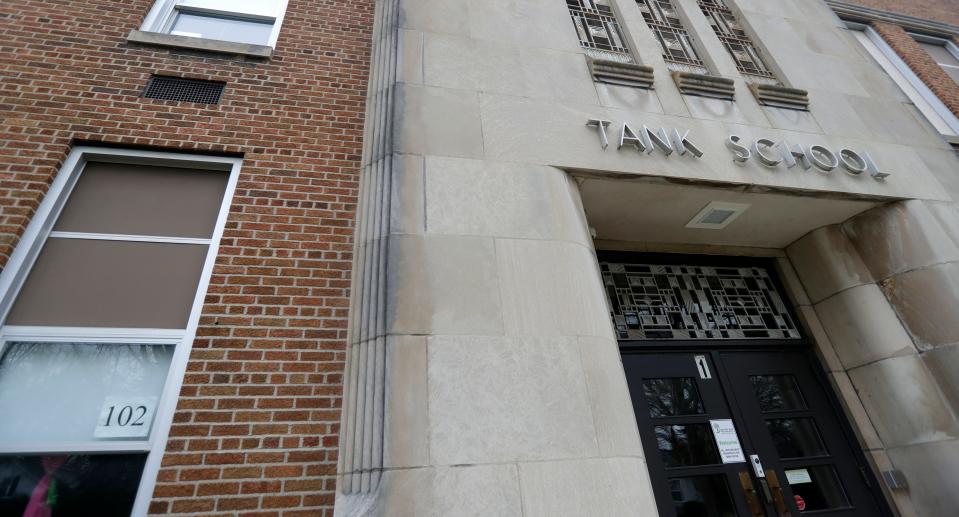Green Bay School Board closes Keller and Tank Elementary schools, approves $336M budget
- Oops!Something went wrong.Please try again later.
GREEN BAY — The Green Bay School Board voted Monday to close both Keller and Tank elementary schools after this school year, hoping to save $1.5 million. It also decided to keep the John Dewey Academy of Learning at its current location and approved the district's $336 million budget.
Board member Andrew Becker raises concerns over closing schools before voting to close district office
Board member Andrew Becker raised concerns about voting to close more schools before the board has voted on closing the district's headquarters on South Broadway. That building was recommended to close by a community task force in May.
"I would really like to have a firm decision made, committing to close this building (the district headquarters) before we start closing schools," he said. "I think the public deserves that commitment."
However, the board did not make any commitment to close the district's downtown building at Monday's meeting.
"The (district office building, or DOB) piece, we're going to bring that forward," Superintendent Claude Tiller said. "... There's a lot that goes into DOB. You can't just facelift and up move sections of DOB because of continuity that has to happen."
The vote was unanimous to close Tank and move students to Lincoln; Becker was the only board member to vote against closing Keller.
The closures come after the board voted in August to close Wequiock Elementary and absorb those students at Red Smith K-8.
The board has yet to make official decisions on six other schools recommended to close as it faces a $7.5 million deficit with less than a year to plan cuts.
Where will Keller and Tank elementary students go?
To reduce operating expenditures, the district plans to close low-enrollment schools and those with high maintenance costs. Keller and Tank were among the 11 schools recommended to close by a community task force in May.
Both Keller and Tank are less than half full.
Keller's 152 students would move to Kennedy Elementary next year where, eventually, a new elementary school would be built to house Kennedy's and MacArthur's students. MacArthur is recommended to close because of a sinking foundation.
More on closures: Why is Green Bay closing schools?
None of the school feeder patterns would change, and all of Keller's students would be eligible for busing.
Tank's 111 students would move to Lincoln Elementary. In the next decade, the district predicts the combined enrollment of Tank and Lincoln won't exceed 300 students. Lincoln has an ideal capacity (90% full) of 320 students.
Board member Nancy Welch, who once taught at Tank and substitute taught at Lincoln, said she thinks it's a "really good move" for students.
The district also said the move would maintain racial diversity and combine feeder patterns. Currently, some of Tank's students go to Lombardi Middle and then Southwest High School while the rest go to Franklin Middle and then West High School.
Lincoln's students follow the Franklin to West feeder pattern, so Tank's cohorts would progress through their educations together. However, feeder patterns could change as a result of recommendations of the boundary task force, which has yet to convene.

What students go to Keller and Tank?
Both Keller and Tank serve grades pre-kindergarten through five and have diverse student populations. Over 75% of students at Keller and Tank are considered economically disadvantaged, according to 2022 Department of Public Instruction enrollment data.
The district says that consolidating the schools will maintain racial diversity, according to a memo from Tiller and his administration.
Here's a breakdown of each school's student population and what it will look like once the schools are combined.
Keller's current student population:
27%: Black
28%: White
15%: Asian
14%: Latino
13%: Two or more races
4%: Native American
Once Keller is consolidated with Kennedy:
15%: Black
35%: White
17%: Asian
16%: Latino
12%: Two or more races
5%: Native American
Tank's student population:
35%: Latino
19%: Black
18%: White
11%: Two or more races
10%: Asian
7%: Native American
1%: Pacific Islander
Once Tank is consolidated under Lincoln:
33%: Latino
17%: Black
27%: White
11%: Two or more races
9%: Asian
4%: Native American
0.3%: Pacific Islander
How much money will be saved by closing Keller and Tank?
The closures of Keller and Tank would knock $1.5 million from the deficit, according to the district's memo. It would also reduce empty seats on the district's west side by 359.
The district estimated that closing Keller will save $622,000 annually. It will save $694,000 in personnel costs through the attrition of about eight full-time equivalent employees, along with $47,000 in utilities savings. Transportation would add between $80,000 and $120,000 in expenditures.
The district would avoid $6.9 million in maintenance, particularly $2.1 million for a new HVAC system at Keller. It was originally installed in 1970 and is 12 years overdue for replacement, according to the memo.
About $317,000 has been invested in Keller over the last decade, according to the district's fixed assets chart.
The district plans to make nonstructural upgrades to Kennedy, such as installing interactive flat-panel televisions to replace chalkboards and lunchroom modifications, despite a new school replacing it in a few years.
More: Green Bay Schools' test scores improve, though still trailing pre-pandemic performance
Closing Tank will save $874,000 annually, in addition to avoiding millions in maintenance, according to district estimates. It expects to save about $915,000 in personnel costs or a reduction of about 10 full-time equivalent employees through districtwide attrition.
The district also expects to save $39,000 in utilities by closing Tank. Adding two more bus routes to facilitate transportation would cost $80,000 a year. Tank is about 1.5 miles from Lincoln Elementary.
About $2.2 million has been invested in Tank's building over the last decade, according to the district's fixed assets chart obtained by the Press-Gazette.
Board decides to not move John Dewey Academy of Learning to West High
The board also decided to keep the John Dewey Academy of Learning at its Cherry Street location instead of absorbing it into West High School, as recommended by the facilities task force.
The board voted to remove moving the charter school to West from a list of project for a 2024 capital referendum. John Dewey can't be moved without future referendum funding, so by default, the school will remain at its location.
The vote narrowly passed, 4-3, with members Bryan Milz, Lynn Gerlach, Becker and Welch voting in favor. Board President Laura McCoy, Vice President James Lyerly and member Laura Laitinen-Warren voted against keeping the school at its current location.
Milz and Becker said John Dewey's specific location and physical layout is what allows the charter school to serve as an alternative format to traditional education.
Green Bay School District approves $336M budget, with higher tax rate
The school board also approved the district's $336 million budget for this school year with a tax rate of $8.26 per $1,000 valuation of property.
This is slightly higher than the $8.15 tax rate the district's Chief Financial Officer Angela Roble recommended at the beginning of the month. The change is largely because the district got less state aid than it anticipated, so it will increase its tax rate to make up the difference, Roble said.
The budget is a 13% increase over last year's $296 million. Almost two-thirds of the district's expenditures come from employee salaries and benefits.
The board approved an 8% salary increase for all employees in August, consistent with the previous year's consumer price index and the highest amount allowed by the Wisconsin Employment Relations Commission. That bakes in an ongoing cost for the district as it faces a $7.5 million deficit next year, down from a $36 million deficit just a year ago.
The district is also paying more into private school vouchers, $2.6 million more. Private school vouchers allow low-income students to attend private schools tuition-free using public tax dollars. Last year, the district paid $8.9 million toward private school vouchers.
While employee wages have increased, the district has made some cuts in other areas. It cut contracted services by about $1.9 million over last year and saved about $2 million in health insurance after making plan reductions.
Green Bay is looking to close the gap on its budget deficit through its facilities master plan and the closure of schools. Despite shrinking the deficit for next year, the district's expenses will continue to outpace its revenues in the future, Roble said.
"We still have to address our declining enrollment issues through our facilities master plan and continue to be strategic on cost reductions," Roble told the Press-Gazette.
How will it affect my taxes?
In Wisconsin, public school districts rely heavily on local property taxes for funding. But they are capped by revenue limits that prevent school districts from generating funds above a specified amount. Property taxes and state funding make up the revenue limit. If state funding goes up, then property taxes go down and vice versa.
The new state budget allowed Green Bay to increase its revenue limit from $10,000 per student to $11,000. Because state aid will not offset the increase in the district's revenue limit, it will increase the tax rate to make up the difference.
School districts use equalized property values for taxes, not assessed values. Equalized property values are the state’s estimate of the full value of property in an area. Equalized values are used to apportion the property tax levy of a school district across its multiple municipalities since district's like Green Bay bridge multiple municipalities.
With a tax rate of $8.26 per $1,000 valuation of property, a resident with a home valued at $250,000 would pay about $2,065 in property taxes. That would be about $65 more than a resident would've paid last year on a house with the same value.
Last year, the district had the lowest tax rate since the 1980s at $8.00 per $1,000 valuation of property, despite voters approving a $92.6 million capital referendum.
Danielle DuClos is a Report for America corps member who covers K-12 education for the Green Bay Press-Gazette. Contact her at dduclos@gannett.com. Follow on Twitter @danielle_duclos. You can directly support her work with a tax-deductible donation at GreenBayPressGazette.com/RFA or by check made out to The GroundTruth Project with subject line Report for America Green Bay Press Gazette Campaign. Address: The GroundTruth Project, Lockbox Services, 9450 SW Gemini Drive, PMB 46837, Beaverton, Oregon 97008-7105.

SUPPORT LOCAL JOURNALISM: Our subscribers make this coverage possible. Click to see the Green Bay Press Gazette's special offers at greenbaypressgazette.com/subscribe and download our app on the App Store or Google Play.
This article originally appeared on Green Bay Press-Gazette: Green Bay School Board closes of Keller and Tank Elementary schools

